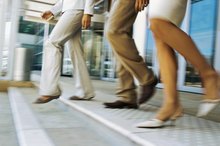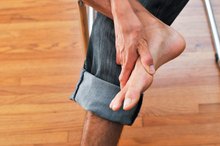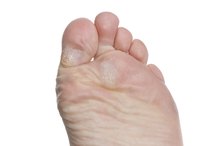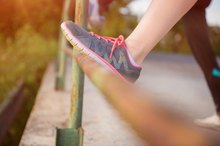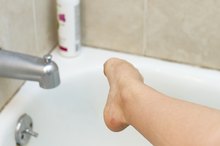What Are the Causes of Seed Corns?
The development of corns and calluses is your skin's way of trying to guard itself from strain, weight and resistance. Corns commonly develop because of improperly fitting shoes. A seed corn, as the name implies, is a small, dry and stiff seed-like bump that can develop anywhere on the foot but typically pops up on the ball or heel of the foot. Seed corns can be prevented by removing the source of the pressure. Corns are not serious and require treatment only if they are irritating.
Shoes
Although the exact cause of seed corns is unknown, they often develop when skin is dry. When footwear doesn't fit correctly or when high-heeled shoes are worn, they apply pressure to certain areas of your foot. Shoes that are too loose-fitting may cause your feet to continually press against the shoe. In some cases, the line of stitching within the shoe may chafe your foot.
- Although the exact cause of seed corns is unknown, they often develop when skin is dry.
- In some cases, the line of stitching within the shoe may chafe your foot.
Socks
Causes of Chronic Ankle & Foot Pain
Learn More
Your feet can be exposed to unnecessary friction if you fail to wear socks with shoes and sandals. Wearing socks or stockings that are too tight or otherwise don’t fit your feet may also lead to problems such as seed corns.
Movement Stress
Seed corns may develop from the pressure and weight caused by repetitive movements, such as walking on a sloping surface or standing or walking on a hard surface, such as concrete, for an extended period. Sometimes seed corns are because of imbalanced walking patterns. This may result in unevenly distributed pressure on the feet, which is referred to as gait or biomechanical abnormalities.
Foot Deformities
Causes of Pain in the Big Toe and Ball of the Foot
Learn More
The Mayo Clinic says foot deformities, such as bunions (an abnormal, bony bump that forms on the joint at the base of your big toe), hammertoe (the toe is bent at the middle joint, so that it resembles a hammer) and bone spurs (bony projections that develop along the edges of bones), may create continual rubbing in your shoe.
Related Articles
References
- National Institute of Health
- DeLauro T and DeLauro M (2012) Chapter 98: Corns and Calluses. Fitzpatrick's Dermatology in General Medicine (8th Edition). New York, New York: McGraw-Hill Education. ISBN-13: 978-0071669047.
- American Academy of Dermatology Association. How to treat corns and calluses. 2019.
- Reddy P, Anusha T, Haritha N, Nagendra A, Bhavani D, Gandhimathi R. Case report on non-surgical treatment for foot corn. International Journal of Dermatopathology and Surgery. 2018;4(1).
- American Academy of Dermatology Association. How to Treat Corns and Calluses. 2019.
- DeLauro T and DeLauro M (2012) Chapter 98: Corns and Calluses. Fitzpatrick's Dermatology in General Medicine (8th Edition). New York, New York: McGraw-Hill Education. ISBN-13: 978-0071669047.
Resources
Writer Bio
Karen Hellesvig-Gaskell is a broadcast journalist who began writing professionally in 1980. Her writing focuses on parenting and health, and has appeared in “Spirituality & Health Magazine" and “Essential Wellness.” Hellesvig-Gaskell has worked with autistic children at the Fraser School in Minneapolis and as a child care assistant for toddlers and preschoolers at the International School of Minnesota, Eden Prairie.

